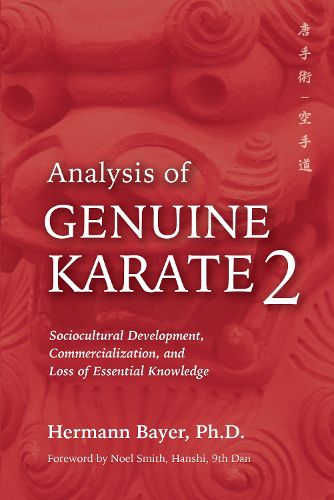Analysis of Genuine Karate 2: Sociocultural Development, Commercialization, and Loss of Essential Knowledge
Hermann Bayer

Analysis of Genuine Karate 2: Sociocultural Development, Commercialization, and Loss of Essential Knowledge
Hermann Bayer
Genuine Okinawan Karate was developed as a fighting tool.
Non-Okinawan Karate are for other purposes.
Karate practitioners, scholars, and everyone caring about Asian martial arts and its culture will enthusiastically appreciate this eye-opening work.
Dr. Bayer substantiates further how the art Karate was used to prepare a nation (Japan) for total war, how it was deliberately industrialized into a worldwide Japanized Karate-Do inflation, and how its following transformation into athletic showmanship destroyed the art’s unity and distinctiveness.
The author endorses Karate-Jutsu as a genuine Okinawan martial art even as foreign knowledge and skills from India (speculated) and from China (proven) were integrated and he explains the imitative social mechanism used to turn this local fighting art into a symbol of national identity.
Since martial arts were initially understood as a moral code-neutral tool, like a weapon, this happens to contradict the modern understanding of Karate being a peaceful art with inherent non-violent values. In truth, moral codes or guidelines on how to use this tool were developed separately, not within the art.
A new back to the roots Karate-Jutsu movement gains importance and establishes a counterculture to Karate-Do’s industrialization, helping to integrate some neglected reminiscences of Karate-Jutsu back into Karate-Do. Such a development brings Japanized Karate-Do versions closer to their martial origins, whereas pure Karate-Jutsu will be preserved as a point of reference by a group of dedicated curators.
Contents include:
Okinawa is the birthplace of Karate-Jutsu and Japan is the birthplace of Bu-Jutsu. How Karate and Budo were used for Japan’s war preparations. Senpai seniority was the social mechanism to integrate Karate into Japan’s martial arts tradition. Consequences of an ancient fighting art being turned into athletic showmanship. In Sports-Karate there is no more Kata in Kumite, and there is no more Kumite in Kata either. The modern misconception of avoiding a fight by all means. The path toward mastery in Karate. Sensei correct your errors and blunders, you have to correct mistakes yourself. Today’s Karate-Jutsu movement is the counterculture to Karate-Do’s industrialization. Karate’s market structure in the 21st century.
This item is not currently in-stock. It can be ordered online and is expected to ship in approx 2 weeks
Our stock data is updated periodically, and availability may change throughout the day for in-demand items. Please call the relevant shop for the most current stock information. Prices are subject to change without notice.
Sign in or become a Readings Member to add this title to a wishlist.


